 Indians Archive
Indians Archive  Indians Prospect Countdown: #61-56
Indians Prospect Countdown: #61-56
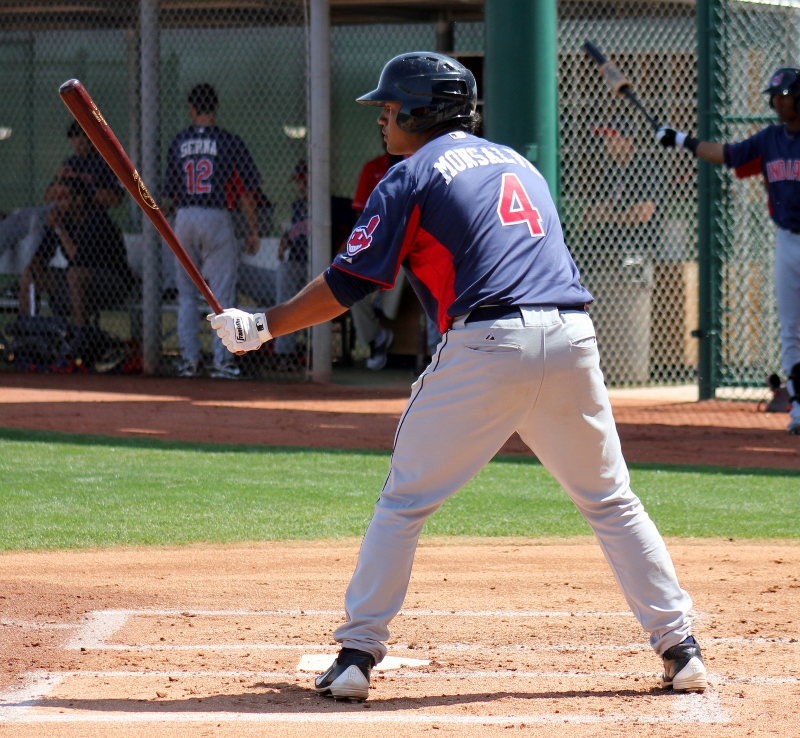 And we're off! The first installment of the top-61 countdown has finally arrived. Hope you're all as excited as I am and I look forward to your feedback, good or bad. Today, we get a look at a young catcher who will play another season in A ball this year, a command and control lefty, a very successful minor league closer, an athletic young 2B who struggled in 2012, a high round draft pick who is struggling to live up to expectations and finally another reliever with some injury issues in his recent past.
And we're off! The first installment of the top-61 countdown has finally arrived. Hope you're all as excited as I am and I look forward to your feedback, good or bad. Today, we get a look at a young catcher who will play another season in A ball this year, a command and control lefty, a very successful minor league closer, an athletic young 2B who struggled in 2012, a high round draft pick who is struggling to live up to expectations and finally another reliever with some injury issues in his recent past.
61. Alex Monsalve, C
DOB: 4/22/1992
Height/Weight: 6-2/225 lb.
Bats/Throws: Right/Right
Acquired: International free agent in 2009
2012 Stats: .256/.311/.373 with 8 HR and 42 RBI in 107 games between Lake County and Carolina
Scouting Report: Monsalve was signed as an international free agent out of Venezuela back in 2009, and worked his way stateside in 2010 to play in 43 games with the Rookie League Arizona Indians. He put up a .557 OPS in the desert, and the Indians moved him up to Lake County for the 2011 season. Monsalve was Midwest League All Star in 2011, and hit .264/.313/.356 with 5 HR and 44 RBI for the Captains as a 19 year old that season. He began 2012 back in Lake County, and after putting up a .730 OPS in 73 games in the Midwest League he was promoted to Carolina. He appeared in 34 games with the Mudcats, hitting just .233/.280/.293 with one HR and 6 RBI.
Monsalve is a big, strong kid behind the plate. He hasn’t put up elite numbers at the dish, but has been young for the levels that he’s been playing at the past two years. He has decent power projection, although his current hit tool is well below average. Monsalve made strides in his pitch recognition and selection last year, striking out 52 times after whiffing 96 times in 2011. He didn’t really improve his walk rate though, and that’s the next step Monsalve has to improve at the dish.
Monsalve has the raw tools to catch, as he’s a good athlete with a strong arm. I’ve been unimpressed with his performance on defense though, as he can sometimes come across as lackadaisical behind the plate and has only thrown out 27% of basestealers in his minor league career. He just doesn’t project as a catcher for me, and if he can’t catch than his bat is very ordinary. He sometime struggles to communicate with pitchers, and doesn’t have the leadership qualities of some of the other catchers in the organization.
Monsalve will probably start off the 2013 season back in Carolina, and I’ll be looking to see if he can continue to make strides with his approach and defense. He’ll still be just 21 years old, and there’s a lot of time for him to identify his weaknesses and make some improvements. The Indians developmental staff is concentrating on improving Monsalve’s actions behind the plate, and I’m looking forward to seeing the changes he’s made in Goodyear later this month.
Glass half-full: Monsalve sticks behind the plate and makes it to The Show as a backup
Glass half-empty: Monsalve moves out from behind the plate and can’t crack a major league roster
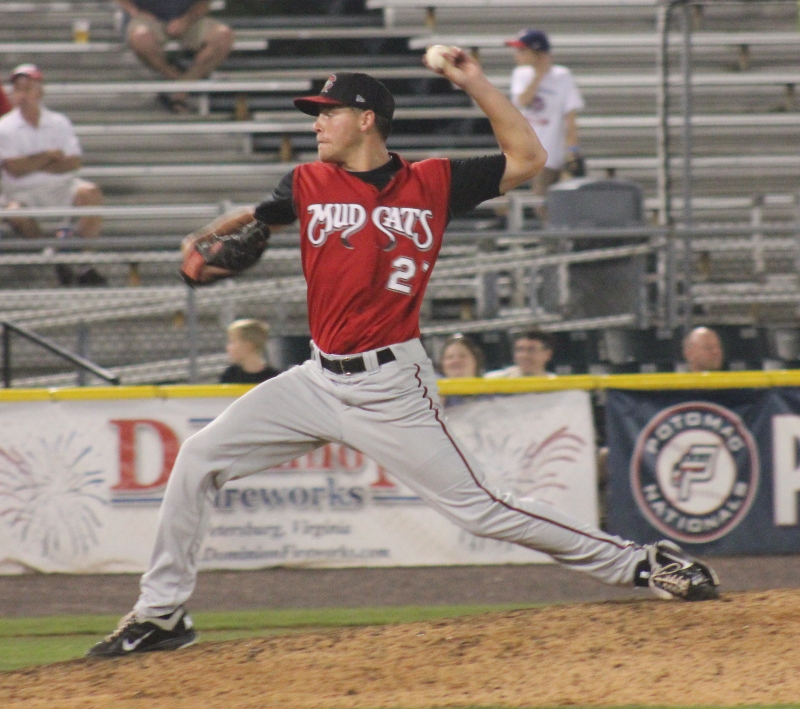 60. Mike Rayl, LHP
60. Mike Rayl, LHP
DOB: 11/1/1988
Height/Weight: 6-5/180 lb.
Bats/Throws: Left/Left
Acquired: 15th round pick in the 2009 MLB draft
2012 Stats: 10-10, 4.49 ERA with 95 K and 59 BB in 152 1/3 IP between Carolina and Akron
Scouting Report: Rayl was drafted by the Washington Nationals in the 41st round of the 2009 draft, but the Nationals were unable to come to terms with the young lefthander and he decided to attend Palm Beach Community College. The Indians snatched him up in the 15th round the very next season, and he made his debut in the Arizona Rookie League later that summer. After an outstanding 2010 in which Rayl posted a 2.81 ERA in 14 starts with Mahoning Valley, Rayl was bumped up to Lake County in 2011. He spend the first half of the season with the Captains, going 5-5 with a 2.83 ERA before being called up to Kinston for eight starts at the end of the year. Rayl continued his steady rise through the organization in 2012, going 10-9 with high-A Carolina with a 4.28 ERA.
Rayl throws a fastball, curveball and changeup. His fastball sits in the high 80’s, and has touched 92. It’s not a pitch that he can use to blow away hitters, and needs to locate it effectively in the zone in order to be effective. The curveball is a better pitch than his changeup, and he feels comfortable throwing it at any time in any count. He has a clean, easily repeatable delivery and feels comfortable challenging hitters. He doesn’t have a true plus offering, and needs to have elite command and control in order to succeed.
Rayl ran into trouble last year due to an abnormally high walk rate. After issuing just 26 free passes in 123 2/3 innings of work in 2011, Rayl walked 59 hitters in 152 1/3 innings last year. His walk rate jumped from 1.9 BB/9 to 3.5 BB/9, a ratio that is untenable if Rayl hopes to succeed at the upper levels of the Indians system. He also allowed 14 HR in 2012 after giving up 9 in 2011, getting hit hard when he fell behind in the count and was forced to be more predictable later in hitter’s counts. When he’s getting ahead with his fastball and attacking hitters with his secondary stuff, he can be successful. If he gives the opposing team free baserunners, they’re going to make him pay.
Rayl is on track to pitch in AA Akron this year as a 24-year old, and will have to improve on his walk rate from last season if he expects to find success in AA. It’s going to get tougher and tougher for Rayl to succeed the higher he climbs on the organizational ladder; if his command isn’t there, he doesn’t have the velocity to fall back on. He’s kind of like a lefthanded Paul Byrd, and we all remember how Byrd could get rocked when his fastball was up in the zone.
Glass half-full: A back of the rotation starter
Glass half-empty: His command isn’t good enough for him to advance to The Show
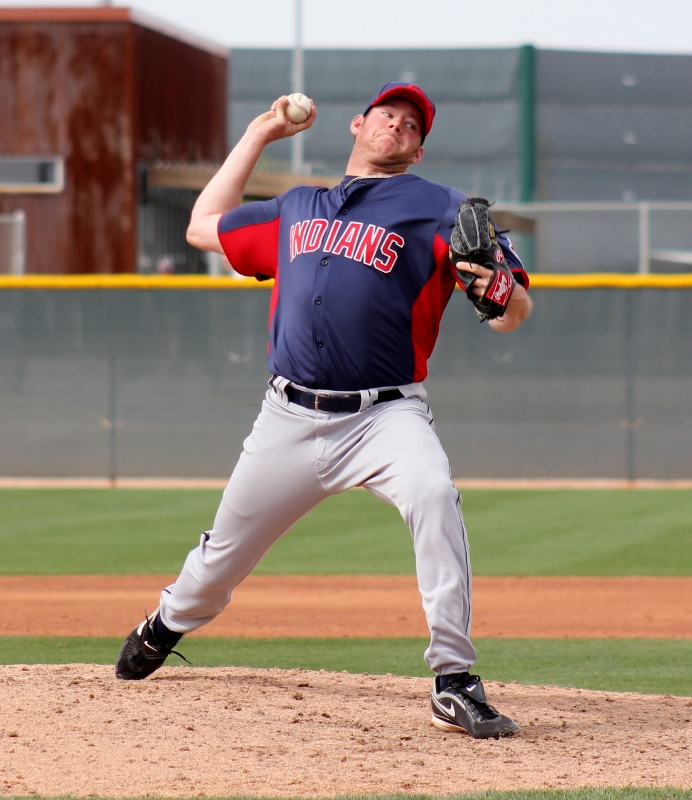 59. Preston Guilmet, RHP
59. Preston Guilmet, RHP
DOB: 07/27/1987
Height/Weight: 6-2/200 lb.
Bats/Throws: Right/Right
Acquired: 9th round pick in the 2009 MLB draft
2012 Stats: 2-2, 24 Saves with a 2.39 ERA, 51 K and 13 BB in 52 2/3 IP
Scouting Report: After starting 15 games for Mahoning Valley after he was drafted in 2009, the former Arizona Wildcat was shifted to a bullpen role. He became the closer for Lake County midway through the 2010 season, and filled that same role for Kinston in 2011 and Akron in 2012. He’s racked up 70 saves in the past three seasons, and has posted a 2.26 ERA since leaving the starting rotation. In addition to the solid ERA, he’s posted an extremely impressive WHIP of 0.938 as a reliever.
Guilmet throws from a unique arm angle, coming at hitters from straight over the top with a very high release point. He’s primarily a two-pitch pitcher, working off of his fastball/splitter combination. His fastball sits in the high 80’s, and tops out at around 91. He commands it extremely well within the zone, and does a nice job spotting the pitch to get ahead in the count. His out pitch is his splitter, a pitch that has excellent action down through the zone that is accentuated by his arm angle. The pitch generates most of Guilmet’s strikeouts, and when hitters do make contact with it a ground ball is generally the result. Every once in a while, he’ll slip up and the pitch will hang in the zone, and that’s when he can get hit hard. Guilmet also throws a slider to give him a pitch with some horizontal movement, but pitches mostly off the fastball/splitter combo.
Guilmet is one of those guys who’s results outpace his scouting reports. Looking solely at his raw numbers, you see a guy who looks like a dominant minor league closer. But when you see him pitch, you see a guy who succeeds based on fastball command and a deceptive delivery. He’s not unlike former Indians minor league reliever Cory Burns. Burns has put up even better numbers than Guilmet in his minor league career, but was roughed up pretty badly in his lone cup of coffee in The Show. Guilmet has already seen both his strikeout and groundball rates drop after his promotion to AA, and as he continues to climb the organizational ladder he will find it tougher and tougher to get by on command and deception alone. It’s tough to be an effective reliever without at least an above-average fastball, but the Indians are hoping Guilmet can continue to buck the trend at AAA Columbus this season.
Glass half-full: A solid backend reliever
Glass half-empty: Guilmet’s lack of velocity catches up to him, and he tops out at AAA
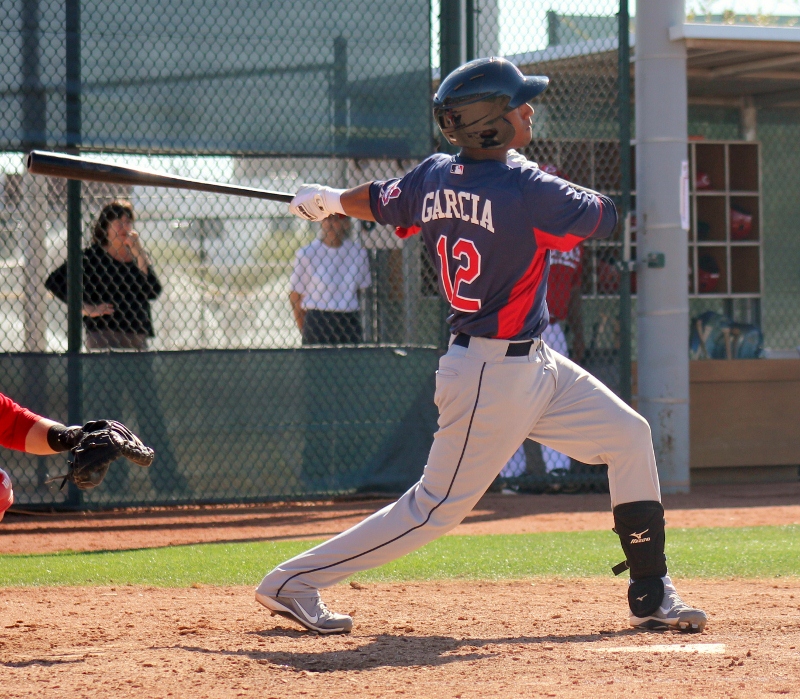 58. Robel Garcia, 2B
58. Robel Garcia, 2B
DOB: 3/28/1993
Height/Weight: 6-0/168 lb.
Bats/Throws: Switch/Right
Acquired: International free agent in 2010
2012 Stats: .217/.304/.302 with 3 HR and 39 RBI in 119 games between Lake County and Mahoning Valley
Scouting Report: Garcia was a member of the Indians Rookie affiliate in Arizona during 2010 and 2011, and had a breakout season in 2011. In Garcia’s 2nd season stateside, he hit a robust .284/.374/.544 with 6 HR and 24 RBI in 45 games in the desert, prompting Indians brass to assign him straight to Lake County in 2012. It was an aggressive assignment for the young infielder, and he was just never able to get untracked in Lake County. He hit .210/.312/.293 in 56 games as a Captain, prompting a move to the New York-Penn League when the Mahoning Valley Scrappers opened play in June. He was a little better with the Scrappers, hitting .210/.298/.309 with 3 HR and 23 RBI in 63 NYPL contests. Still, it was a disappointing season for the athletic young 2B who many (myself included) were expecting big things from in 2012.
Garcia was an international signing out of the Dominican Republic in 2010, and has quick, strong hands at the plate. He projects to have at least average power at full maturity, although his current power tool is below average. He has a decent approach at the plate, as despite 112 K’s last year he did manage to draw 50 walks. Like many young international signings, he still struggles with breaking pitches, particularly sliders down and out of the strike zone. He needs to improve his pitch recognition and selection, but that’s to be expected for a player with his experience. He’s a switch hitter, but for his career is better as a lefthanded hitter (.803 OPS) than righthanded hitter (.658 OPS).
Defensively, has appeared in games at 2B, 3B and SS as a pro. He’s primarily been a second baseman, but is athletic enough to handle other positions as well. He made 7 errors in 37 games at 2B, and committed 6 miscues in just 19 games at short. His arm is above-average, and he needs to work on his footwork and actions in the field. He has all of the tools to be at least an average 2B, he just needs some additional reps in the field.
After putting up a .613 OPS in Arizona in 2010, Garcia bounced back with a .915 OPS in the same circuit in 2011. That’s a sign that he could have a rebound year in his 2nd tour of the Midwest League in 2013. Garcia should open as the Captains opening day 2B, and will definitely be a guy that I have my eye on this season. He’s a prime rebound candidate this season, and is a guy who could find himself back in the top half of this list come 2014. He’s still just 19 years old, and has a lot of maturing to do before he’s a finished product.
Glass half-full: A 1st division starter at 2B
Glass half-empty: A solid AA 2B
 57. Jake Sisco, RHP
57. Jake Sisco, RHP
DOB: 12/9/1991
Height/Weight: 6-3/185
Bats/Throws: Right/Right
Acquired: 3rd round pick in the 2011 MLB draft
2012 Stats: 1-6 with a 5.03 ERA, 45 K and 30 BB in 77 IP with Mahoning Valley
Scouting Report: The 2011 draft saw the Indians pay overslot bonuses to their first two picks, shortstop Francisco Lindor and high school pitcher Dillon Howard. Their third pick was more of a signability selection, righthanded pitcher Jake Sisco out of Merced College in California. Sisco signed well before either Lindor or Howard, and made 12 appearances with the Rookie League Arizona Indians in 2011, going 2-4 with a 5.24 ERA. He was held in extended spring training last year until the short season New York-Penn League started up in June, and made 15 starts for the Mahoning Valley Scrappers. Sisco had a rough campaign with the Scrappers, going 1-6 with a 5.03 ERA. He struck out just 45 hitters in 77 IP, walking 30 and allowing 81 base hits. For a college pitcher drafted in the 3rd round pitching in the NYPL, that season has to be considered a disappointment.
Sisco throws a fastball, curveball, slider and changeup. The fastball sits between 91-94 MPH, and is an above-average pitch when he’s locating it effectively. The curveball is his best secondary offering, but rarely flashes more than above-average. Both the slider and change project to be average pitches, but not much more than that. It’s a starter’s arsenal in terms of pitch variations, but Sisco is going to have to make strides in improving at least one of his offspeed pitches to help him attack hitters more effectively. As of right now, the only pitch he’s really comfortable throwing when he’s behind in the count is his fastball, and that’s what was getting him into trouble in the NYPL last season.
Sisco should open 2013 in the rotation for Lake County, and the 21-year old will need to make significant strides in both his scouting reports and his stuff in order to solidify and improve his prospect standing. If you catch a Lake County game where Sisco is pitching, pay attention to more than just the radar gun readings; Sisco’s development will be governed much more by his location and improvements in secondary stuff than by how hard he throws in 2013.
Glass half-full: Improvements in his offspeed stuff allow Sisco to develop as a back of the rotation starter
Glass half-empty: Sisco continues to rely on his fastball and is shifted to a bullpen role
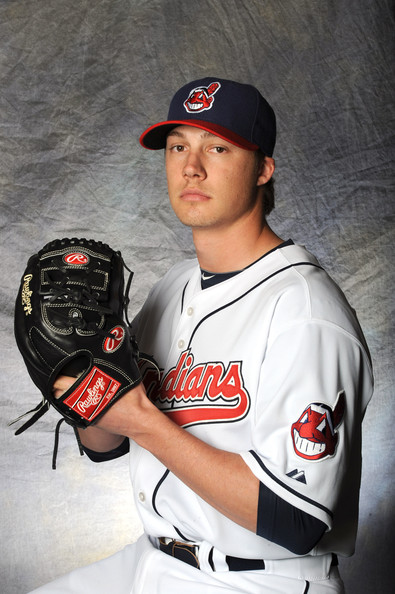 56. Tyler Sturdevant, RHP
56. Tyler Sturdevant, RHP
DOB: 12/20/1985
Height/Weight: 6-1/190 lb.
Bats/Throws: Right/Right
Acquired: 27th round pick in the 2009 MLB draft
2012 Stats: 1-3 with a 4.42 ERA, 28 K and 14 BB in 36 2/3 IP between Carolina, Akron and Columbus
Scouting Report: Sturdevant was a 27th round pick out of New Mexico State in 2009. He was a starter in college, but the Indians immediately converted him to a relief role and Sturdevant has never started a game as a professional. He put up some impressive strikeout totals in his first three seasons as a professional, racking up 215 K’s in just 175 1/3 innings of work. Sturdevant was injured to begin the 2012 season though, and didn’t debut until June with the Carolina Mudcats. After 7 innings in Carolina and 9 2/3 innings in Akron, Sturdevant was promoted to AAA Columbus for the rest of the season. In 20 innings with the Clippers, he put up a 6.30 ERA with 15 K and 9 BB in 20 IP. It wasn’t the season that anyone had envisioned for Sturdevant, as the injury and ineffectiveness resulted in a disappointing campaign for the power righty.
Sturdevant has an above-average fastball that sits consistently in the 92-94 MPH range and can touch 97. He compliments the fastball with an excellent cutter, which is probably his best offering. It’s a true out pitch, and he does a nice job setting hitters up with the heat and then attacking them with the cutter. It’s an especially tough pitch on righties, and in 2011 he struck out nearly 30% of the righthanded hitters that he faced between all three minor league levels. He also throws a curveball and changeup, but he pretty much sticks to his two-pitch mix of the fastball and cutter out of the bullpen. In short stints, he really doesn’t need much more than those two offerings as long as he’s locating them effectively.
Sturdevant is 27 years old, and is getting to an age where he’s really no longer a prospect. He should start the season healthy and back in AAA Columbus, and this is really a make or break season for the reliever. He’s only thrown 23 2/3 innings at the AAA level, and his ERA as a Clipper is over 6.00. If he can be as effective in Columbus as he’s been in Kinston and Akron, then Sturdevant could be a major league option as early as 2013. But if his stuff won’t translate to the International League, than he can never really be expected to get American League hitters out either.
Glass half-full: A solid middle relief option
Glass half-empty: He flames out at the AAA level
- NBA Announces 2013-2014 Schedule
- Browns Ink Sharknado
- Sharknado A No-Show For Rookie Camp
- Trent Richardson Out Until Training Camp
- Browns Sign Brandon Jackson
- Carrasco Suspended Eight Games
- Browns Add to Wide Receiver Depth with David Nelson
- Browns Need to Learn from Past Draft Mistakes
- Browns Release Chris Gocong and Usama Young
- Browns Missing on Grimes Disappointing, But Not The End
The TCF Forums
- Chris Grant's first 3 drafts
Kingpin74 (Tuesday, January 21 2014 10:13 AM) - The 2014 Offseason Thread
googleeph2 (Tuesday, January 21 2014 9:36 AM) - 2015 Recruiting
furls (Tuesday, January 21 2014 6:57 AM) - Mike Brown
YahooFanChicago (Monday, January 20 2014 11:15 PM) - Movies coming out
HoodooMan (Monday, January 20 2014 9:34 PM) - 2014 Hoops Hockey Hijinx
jpd1224 (Monday, January 20 2014 4:44 PM) - 2014 Recruiting
jclvd_23 (Monday, January 20 2014 2:26 PM) - Wish List - #4 Pick
Hikohadon (Monday, January 20 2014 1:26 PM) - Official- Browns Coach Search/Rumors
OldDawg (Sunday, January 19 2014 6:48 PM) - #1 overall pick Anthony Bennett
TouchEmAllTime (Sunday, January 19 2014 1:28 PM)



